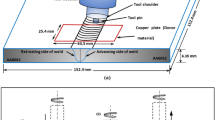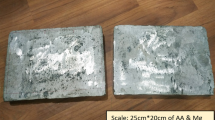Abstract
This research investigation focuses on copper (Cu) donor material assisted friction stir welding (FSW) of AA2024-T4 and AA6061-T6 plates of 6.35 mm thickness. FSW joints were prepared at optimized process parameters of 1400 rpm and welding speeds of 1, 2, or 3 mm/s. The Cu donor material of 25% and 50% thickness with respect to the workpiece thickness were selected to assist the FSW joining during the plunge stage. The downward force generated in the FSW process was gradually decreased after introducing the Cu donor material because more heat was produced in the donor material and conducted to the base plate. The temperature profiles that the inclusion of the Cu donor material increased the temperature at the beginning of the welding process. The welded joints were characterized in terms of the micro-hardness and tensile properties. Defect-free joints could be obtained when placing high strength AA2024 alloy at the advancing side of the weld with 25% thick donor material. From the hardness profiles, it is observed that the hardness decreases from the base metal of AA 2024 to the center of the weld followed by thermomechanical affected zone (TMAZ) and the heat affected zone (HAZ). The hardness measurements are lower in the TMAZ and HAZ where tensile failure occurs. The maximum tensile strength improved by 130% with 25% Cu donor material as compared to the as welded samples. SEM Fractography images confirmed mixed modes of brittle and ductile fracture surfaces with tearing ridges and finer dimples after the inclusion of donor material in FSW.








Similar content being viewed by others
Change history
03 July 2023
A Correction to this paper has been published: https://doi.org/10.1007/s00170-023-11860-w
References
Kumar N, Yuan W, Mishra R (2015) Friction stir welding of dissimilar alloys and materials. Elsevier
da Silva AAM, Arruti E, Janeiro G, Aldanondo E, Alvarez P, Echeverria A (2011) Material flow and mechanical behaviour of dissimilar AA2024-T3 and AA7075-T6 aluminium alloys friction stir welds. Mater Des 32:2021–2027
Cavaliere P, De Santis A, Panella F, Squillace A (2009) Effect of welding parameters on mechanical and microstructural properties of dissimilar AA6082–AA2024 joints produced by friction stir welding. Mater Des 30:609–616
Cavaliere P, Cerri E, Squillace A (2005) Mechanical response of 2024–7075 aluminium alloys jointed by friction stir welding. J Mater Sci 40:3669–3676
Ahn J, Chen L, He E, Dear JP, Davies CM (2018) Optimisation of process parameters and weld shape of high power Yb-fibre laser welded 2024–T3 aluminium alloy. J Manuf Process 34:70–85
Kareem A, Qudeiri JA, Abdudeen A, Ahammed T, Ziout A (2021) A review on AA 6061 metal matrix composites produced by stir casting. Materials 14(1):175
Lee WB, Yeon YM, Jung SB (2003) The mechanical properties related to the dominant microstructure in the weld zone of dissimilar aluminium alloys joints by friction stir welding. J Mater Sci 38:4183–4191
Heidarzadeh A, Khodaverdizadeh H, Mahmoudi A, Nazari E (2012) Tensile behavior of friction stir welded AA 6061–T4 aluminum alloy joints. Mater Des 37:166–173
Ouyang JH, Kovacevic R (2002) Material flow and microstructure in the friction stir butt welds of the same and dissimilar aluminum alloys. J Mater Eng Perform 11:51–63
Guo JF, Chen HC, Sun CN, Bi G, Sun Z, Wei J (2014) Friction stir welding of dissimilar materials between AA6061 and AA7075 Al alloys effects of process parameters. Mater Des 56:185–192
Bala Srinivasan P, Dietzel W, Zettler R, Dos Santos JF, Sivasan W (2005) Stress corrosion cracking susceptibility of friction stir welded AA7075-AA6056 dissimilar joint. Mater Sci Eng A 392:292–300
Sadeesh P, Venkatesh Kannan M, Rajkumar V, Avinash P, Arivazhagan N, Devendranath Ramkumar K, Narayanan S (2014) Studies on friction stir welding of AA 2024 and AA 6061 dissimilar metals. Procedia Eng 75:145–149
Amancio-Filho ST, Sheikhi S, Dos Santos JF, Bolfarini C (2008) Preliminary study on the microstructure and mechanical properties of dissimilar friction stir welds in aircraft aluminium alloys 2024–T351 and 6056–T4. J Mater Process Technol 206:132–142
Song S-W, Kim B-C, Yoon T-J, Kim N-K, Kim I-B, Kang C-Y (2010) Effect of welding parameters on weld formation and mechanical properties in dissimilar Al alloy joints by FSW. Mater Trans 51(7):1319–1325
Naik BS, Wu Z, Maniscalco J, Elmustafa A (2022) Effect of copper donor material assisted friction stir welding of AA6061-T6 alloy on downward force, microstructure, and mechanical properties. Int J Adv Manuf Technol 119(5):2847–2862
ASTM E8/E8M-13a (2013) Standard test methods for tension testing of metallic materials. ASTM International, West Conshohocken, PA, USA
Banik A, Barma JD, Saha SC (2020) Effect of threaded pin tool for friction stir welding of AA6061-T6 at varying traverse speeds: torque and force analysis. Iran J Sci Technol Trans Mech Eng 44:749–764
Lambiase F, Paoletti A, Di Ilio A (2018) Forces and temperature variation during friction stir welding of aluminum alloy AA6082-T6. Int J Adv Manuf Technol 99:337–346
Jamshidi Aval H, Serajzadeh S, Kokabi AH (2012) Experimental and theoretical evaluations of thermal histories and residual stresses in dissimilar friction stir welding of AA5086-AA6061. Int J Adv Manuf Technol 61:149–160
Ojha M, Al-Allaq AH, Mohammed YS, Bhukya SN, Wu Z, Elmustafa AA (2023) Elastic properties of the nonmixing copper donor assisted material in friction stir welding of aluminum alloys using nanoindentation. Front Met Alloy 2:1129126. https://doi.org/10.3389/ftmal.2023.1129126
Al-Allaq AH, Ojha M, Mohammed YS, Bhukya SN, Wu Z and Elmustafa AA (2023) Post Weld Heat Treatment Effects on Microstructure, Crystal Structure, and Mechanical Properties of Donor Stir Assisted Friction Stir Welding Material of AA6061-T6 Alloy, submission to International Journal of Advanced Manufacturing Technology. https://doi.org/10.21203/rs.3.rs-2720330/v1
Acknowledgements
The authors would like to acknowledge support from NASA (award number: 80NSSC20M0015). The author ZW also acknowledges support from ONR (award number: N00014-19-1-2728). Any opinions, findings, and conclusions or recommendations expressed in this material are those of the author(s) and do not necessarily reflect the views of the NASA and ONR. The authors would also like to thank the Commonwealth Center for Advanced Manufacturing (CCAM) and Amsted Rail for providing the facility for sample characterization. The assistance of Mr. Geoff Widman in performing the experiments is also gratefully acknowledged.
Funding
The authors would like to acknowledge support from NASA (award number: 80NSSC20M0015). The author ZW also acknowledges support from ONR (award number: N00014-19–1-2728). Any opinions, findings, and conclusions or recommendations expressed in this material are those of the author(s) and do not necessarily reflect the views of the NASA and ONR.
Author information
Authors and Affiliations
Contributions
Dr. S. Bhukya carried out experimentation and data analysis, and wrote/revised the manuscript. Dr. Z. Wu, as the Principal Investigator, secured funding and resources for the research, designed and carried out the experiment, wrote and revised the manuscript. Dr. A. Elmustafa reviewed and revised the manuscript. Mr. A. Al-Allaq, Mr. M. Ojha, and Dr. Y. Mohammed characterized samples.
Corresponding author
Ethics declarations
Competing interests
The authors have no relevant financial/non-financial interest neither conflicts of interest to disclose.
Additional information
Publisher's note
Springer Nature remains neutral with regard to jurisdictional claims in published maps and institutional affiliations.
The original online version of this article was revised: Figure 2 citation should not be in this sentence “The positions of the points where the temperature was measured on both sides are selected on two different cross sections, respectively.”
Rights and permissions
Springer Nature or its licensor (e.g. a society or other partner) holds exclusive rights to this article under a publishing agreement with the author(s) or other rightsholder(s); author self-archiving of the accepted manuscript version of this article is solely governed by the terms of such publishing agreement and applicable law.
About this article
Cite this article
Bhukya, S.N., Wu, Z., Elmustafa, A. et al. Cu donor material assisted friction stir welding of AA2024 and AA6061 dissimilar alloys: Effect on downward force, temperature profile, and mechanical properties. Int J Adv Manuf Technol 127, 3839–3851 (2023). https://doi.org/10.1007/s00170-023-11778-3
Received:
Accepted:
Published:
Issue Date:
DOI: https://doi.org/10.1007/s00170-023-11778-3




